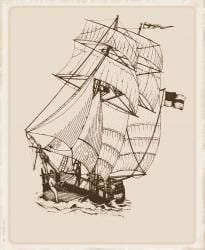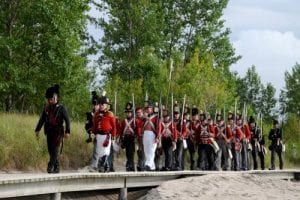HMS Nancy
The Beginning

©Wasaga Beach Provincial Park
The HMS Nancy was built for the fur trade in 1789 at the British port of Detroit. John Richardson, of Montreal’s Richardson, Forsyth and Company, supervised the construction of the schooner. Upon Nancy’s completion, she measured approximately 80 feet in length, 22 feet in width (or beam), and had a depth of hold of 8 feet. John Richardson wrote from Detroit in 1789 to his partner:
“The schooner will be a perfect masterpiece of workmanship and beauty. The expense to us will be great, but there will be the satisfaction of her being strong and very durable. Her floor-timbers, keel, keel-son, stem, and lower futtocks are oak. The transom, stern-post, upper futtocks, top timbers, beams and knees are all red cedar. She will carry 350 barrels.”
The carved figurehead on the vessel of “a lady dressed in the present fashion, and with a hat and a feather” was done by Skelling of New York. The Nancy was likely named for either the wife or daughter of John Richardson.
The Fur Trade
Under the command of Captain William Mills, the Nancy served the fur trade by carrying goods up the Great Lakes including food, rum, clothing, blankets, tools, weapons and ammunition, and returning with furs.
There were two main ports in the west at the time of the Nancy’s involvement in the fur trade: Grand Portage at Sault Ste. Marie, which governed access to Lake Superior and the north; and further west in the Straits of Mackinaw, Fort Mackinac, a vitaltrading post that commanded Lake Huron, Lake Michigan and the west.
In 1793, the Schooner was sold to George Leith and Company and in turn toward the end of the century sold to the North West Fur Company. Captain Mills commanded the Nancy until 1805 when he was succeeded by Captain Alexander Mackintosh. In the service of both companies, the Nancy’s function remained as a transportation vessel for fur and merchandise on Lakes Erie, Huron and Michigan.
War
 When the United States declared war against Britain in 1812, the Nancy was requisitioned as a British transport by Lieutenant-Colonel St. George, commander of the garrison. In Colonel Matthews Willot’s inventory to Sir Isaac Brock, the Nancy was described as capable of mounting six four-pounded carriage guns and six swivel guns.
When the United States declared war against Britain in 1812, the Nancy was requisitioned as a British transport by Lieutenant-Colonel St. George, commander of the garrison. In Colonel Matthews Willot’s inventory to Sir Isaac Brock, the Nancy was described as capable of mounting six four-pounded carriage guns and six swivel guns.
At the outset of war there were three main transportation routes from Montreal to the Northwest. One route was via the Ottawa and French Rivers and Georgian Bay; the second by way of Lakes Ontario, Erie, St. Clair and Huron. A third, overland, route was from Lake Ontario at York (Toronto), using Yonge Street to Holland Landing and the Holland River. From there, the route entered Lake Simcoe and led to Kempenfeldt Bay (Barrie) where Nine Mile Portage connected to Willow Creek, the Nottawasaga River and Lake Huron. The latter route became the main supply line during the last year of the war.
The Nancy Escapes
On September 10, 1813, while the Nancy was away at Fort Mackinac, the British fleet was defeated in the Battle of Lake Erie, leaving the Nancy as the sole surviving British ship on the Upper Great Lakes. Captain Mackintosh, upon returning with the Nancy to the mouth of the St. Clair River on October 5, found Detroit and Amherstburg in American hands. Laying in wait of his arrival were two armed schooners and a gun boat; at noon the following day the Nancy was under attack. By October 7, Mackintosh had her under sail to Sault Ste. Marie, where she wintered.
After the Battle of Lake Erie, the Americans planned to recapture Fort Mackinac, which they had lost on July 17, 1812. During the spring of 1814, the Nancy made three round trips from Fort Mackinac to the mouth of the Nottawasaga River for supplies. On July 3, 1814, as the American fleet left Detroit for Fort Mackinac, the Nancy was at the Nottawasaga supply base for the fourth time. At the base, the Nancy was moved 3 kilometres (2 miles) up river under the command of Royal Navy Lieutenant Miller Worsley. Here, quietly hidden and protected by a blockhouse, the Nancy waited.
Discovery
On August 14, 1814, three American ships, Niagara, Tigress, and Scorpion, under command of Captain Sinclair, arrived at the mouth of the Nottawasaga River to wait for the British schooner, which was thought to be en route from Fort Mackinac. It was only when wood gathering parties from the American ships happened upon the Nancy in her hiding spot, that the secret was revealed.
The engagement was brief and decisive. Lieutenant Worsley’s force consisted of 22 seamen, 23 Anishinaabe-Ojibwe under command of Lieutenant Ramsay Livingston, and nine French Canadian voyageurs. Their armament consisted of two 24-pounder carronades and one 6-pounder long gun. The American force of three ships and 500 men armed with eighteen 32-pounder carronades, two 24-pounder long guns, and one 5.5 inch howitzer provided formidable odds. Captain Sinclair anchored his ships in the Bay and proceeded to pound the Nancy and the blockhouse across the narrow neck of land, which separated the river from the bay.
The situation was hopeless. Lieutenant Worsley decided to destroy the Nancy rather than allow her to fall into enemy hands. However, during the preparations for blowing up the schooner, a direct hit on the blockhouse set the Nancy afire. She burned to the waterline and sank. The British force escaped into the forest without pursuit.
After the action, the Scorpion and Tigress were left to guard the river to prevent canoes and bateaux from getting supplies to Fort Mackinac. Eventually the river mouth was blocked with felled trees and the ships proceeded along the north shore in the hope of intercepting fur-laden canoes on the lake.
The Nancy Avenged
On August 31, Worsley and his men, after paddling and rowing for 600 kilometres (360 miles), reached Mackinac. En route, they had bypassed the Tigress and Scorpion. On September 3, Worsley and 92 men in four rowboats returned to surprise and capture the Tigress at midnight in Detour Passage. The following day, the Scorpion was lured into position and also captured. Both vessels were then taken to Fort Mackinac. The Scorpion was renamed Confiance in honour of the British ship and the Tigress was renamed Surprise for the manner in which she was captured.
After the war, the Northwest Fur Company was awarded 2,200 pounds in compensation for the Nancy. In addition to this, 500 pounds was awarded for the two round trips between Detroit and Fort Erie in 1812, and for service in 1813 and 1814, 1,243 pounds, 5 shillings.
Nancy Island

Raising HMS Nancy
Gradually, the river currents deposited silt and sand about the sunken hull and an island was formed. On July 1, 1911, Mr. C.J.H. Snider located the hull, which was visible just beneath the water. It was not until August 1924, when an American 24-pounder round shot was found in the riverbank by Dr. F.J. Conboy that interest was renewed. The long-covered hull was rediscovered by Dr. Conboy, whose interest was spurred by Mr. Snider, during the summer of 1925.
The Dominion and Provincial Governments, as well as many individuals, became interested in the historic site and in 1928 the hull was raised and placed on the island. On August 14, 1928, 114 years after the gallant defence of the Nancy, the Nancy museum was officially opened, on the island she helped to form, to commemorate this episode in the War of 1812.
